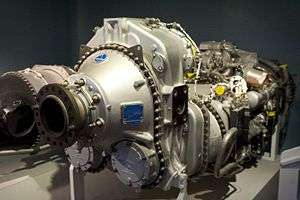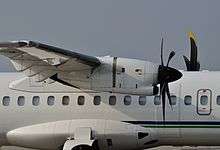Pratt & Whitney Canada PW100
| PW100 | |
|---|---|
 | |
| PW120 in Canada Aviation Museum | |
| Type | Turboprop |
| National origin | Canada |
| Manufacturer | Pratt & Whitney Canada |
| First run | 1984 (entered service) |
| Major applications | ATR 42/ATR 72 Bombardier Dash 8 EADS CASA C-295 Embraer EMB 120 Brasilia Fokker 50 Xian MA60 |
The Pratt & Whitney Canada PW100 aircraft engine family is a series of 1,800 to 5,000 shaft horsepower (1,300 to 3,700 kW) turboprops manufactured by Pratt & Whitney Canada. The engine first entered service in 1984. It dominates its market with 89% of the turboprop regional airliner installed base in 2016, leading GE Aviation and Allison Engine Company.[1]
Design
Originally called the PT7, the PW100 uses a relatively unusual three-shaft engine configuration. In the PW100, a centrifugal LP impeller (except for the PW150 which uses a 3-stage axial LP compressor), driven by a single stage LP turbine, supercharges a centrifugal HP impeller, driven by a single stage HP turbine. Power is delivered to the offset propeller reduction gearbox via a third shaft, connected to a two-stage free (power) turbine.
Variants
- PW115
- Rated at 1,500 shp (1,100 kW).[2] No longer in service.[3]
- PW118
- Certified in 1986 with a maximum continuous rating of 1892 eshp (1411 kW), can be converted to a PW118A.[3]
- PW118A
- Certified in 1987 with a maximum continuous rating of 1893 eshp (1412 kW), can be converted to a PW118B.[3]
- PW118B
- Certified in 1996 with a maximum continuous rating of 1892 eshp (1412 kW).[3]
- PW119
- No longer in service.[3]
- PW119A
- Certified in 1992 with a maximum continuous rating of 1948 eshp (1453 kW), can be converted to a PW119B.[3]
- PW119B
- Certified in 1993 with a maximum continuous rating of 1941 eshp (1448 kW), can be converted to a PW119C.[3]
- PW119C
- Certified in 1995 with a maximum continuous rating of 1941 eshp (1448 kW), can be converted to a PW119B.[3]
- PW120
- Certified in 1983 with a maximum continuous rating of 1787 eshp (1333 kW), can be converted to a PW121.[3]
- PW120A
- Certified in 1984 with a maximum continuous rating of 1892 eshp (1411 kW), can be converted to a PW121.[3]
- PW121
- Certified in 1987 with a maximum continuous rating of 2044 eshp (1524 kW), can be converted to a PW120.[3]
- PW121A
- Certified in 1995 with a maximum continuous rating of 1992 eshp (1465 kW).[3]

- PW123
- Certified in 1987 with a maximum continuous rating of 2261 eshp (1687 kW), can be converted to a PW123B, C, D or E.[3]
- PW123AF
- Certified in 1989 with a maximum continuous rating of 2261 eshp (1686 kW), can be converted to PW123.[3]
- PW123B
- Certified in 1991 with a maximum continuous rating of 2262 eshp (1687 kW), can be converted to a PW123.[3]
- PW123C
- Certified in 1994 with a maximum continuous rating of 2054 eshp (1532 kW), can be converted to a PW123 or D.[3]
- PW123D
- Certified in 1994 with a maximum continuous rating of 2054 eshp (1532 kW), can be converted to a PW123 or C.[3]
- PW123E
- Certified in 1995 with a maximum continuous rating of 2261 eshp (1687 kW), can be converted to a PW123.[3]
- PW124
- No longer in service.[3]
- PW124A
- No longer in service.[3]
- PW124B
- Certified in 1988 with a maximum continuous rating of 2522 eshp (1881 kW), can be converted to a PW123 or PW127.[3]
- PW125
- No longer in service.[3]
- PW125A
- No longer in service.[3]
- PW125B
- Certified in 1987 with a maximum continuous rating of 2261 eshp (1687 kW).[3]
- PW126
- Certified in 1987 with a maximum continuous rating of 2323 eshp (1732 kW) can be converted to a PW123 or PW126A.[3]
- PW126A
- Certified in 1989 with a maximum continuous rating of 2493 eshp (1859 kW), can be converted to a PW123 or PW127D.[3]
- PW127
- Certified in 1992 with a maximum continuous rating of 2619 eshp (1953 kW), can be converted to a PW127C,E or F.[3]
- PW127A
- Certified in 1992 with a maximum continuous rating of 2620 eshp (1954 kW), can be converted to a PW127B.[3]
- PW127B
- Certified in 1992 with a maximum continuous rating of 2619 eshp (1953 kW).[3]
- PW127C
- Certified in 1992 with a maximum continuous rating of 2880 eshp (2148 kW).[3]
- PW127D
- Certified in 1993 with a maximum continuous rating of 2880 eshp (2148 kW), can be converted to a PW127B.[3]
- PW127E

- Certified in 1994 with a maximum continuous rating of 2516 eshp (1876 kW), can be converted to a PW127M.[3]
- PW127F
- Certified in 1996 with a maximum continuous rating of 2619 eshp (1953 kW), can be converted to a PW127M.[3]

- PW127G
- Certified in 1997 with a maximum continuous rating of 3058 eshp (2281 kW).[3]
- PW127H
- Certified in 1998 with a maximum continuous rating of 2880 eshp (2148 kW).[3]
- PW127J
- Certified in 1999 with a maximum continuous rating of 2880 eshp (2148 kW).[3]
- PW127M
- Certified in 2007 with a maximum continuous rating of 2619 eshp (1953 kW).[3]
- PW150A
- Certified in 1998-06-24 with a maximum continuous rating of 5071 SHP (3782 kW),[3] although capable of up to 7000 SHP. Has a 3 stage axial low pressure compressor instead of the centrifugal NL unit on other variants. Used on the Bombardier Q400 and Antonov An-132.
- ST18M
- marine application for PW100
- ST40M
- marine application for PW150A
Applications
Aircraft

- Antonov An-132D (PW150A)
- ATR 42 (PW120 on -300, PW121 on -320, PW127E on -500, PW127M on -600)
- ATR 72 (PW124B on -100 -200, PW127F or M on -500, PW127M on -600)
- BAe ATP (PW126)
- Bombardier 415 (PW123AF)
- Bombardier CL-215T (PW123AF)
- Bombardier Q100 (PW121)
- Bombardier Q200/Q300 (PW123)
- Bombardier Q400 (PW150)
- Canadair CL-415 (PW123AF)
- Dornier 328 (PW119)
- EADS CASA C-295 (PW127G)
- Embraer EMB 120 Brasilia (PW115, latterly PW118A)
- Euromil Mi-38 (PW127TS)
- Fokker 50 (PW125B)
- Fokker 60 (PW127B)
- Ilyushin Il-114 (PW127H)
- Xian MA60 (PW127J)
Other applications
- Bombardier JetTrain
- Skjold-class corvette
Specifications
| Series | Thermo. ESHP | Mech. SHP | Prop. max. RPM | Height | Width | Length | Application |
|---|---|---|---|---|---|---|---|
| PW118 | 2,180 | 1,800 | 1,300 | 31 in | 25 in | 81 in | Embraer 120 |
| PW120 | 2,400 | 2,100 | 1,200 | 31 in | 25 in | 84 in | ATR 42-300/320, Dash 8 Q100 |
| PW123/124 | 3,000 | 2,400 | 1,200 | 33 in | 26 in | 84 in | Bombardier Dash 8 Q200/Q300, Canadair CL-215T/CL-415 |
| PW127 | 3,200 | 2,750 | 1,200 | 33 in | 26 in | 84 in | ATR 42-400/500, ATR 72-210/500, CASA C-295, Il-114-100, Xian MA60 |
| PW150 | 6,200 | 5,000 | 1,020 | 44 in | 30 in | 95 in | Dash 8 Q400 |
General characteristics
- Type: Turboprop
- Length: 2,046–2,130 mm (80.6–83.9 in), PW150 : 2,420 mm (95 in)
- Diameter: 635–679 mm (25.0–26.7 in), PW150 : 790 mm (31 in)
- Dry weight: 390.5–481.7 kg (861–1,062 lb), PW150 : 716.9 kg (1,580 lb)
Components
- Compressor: Two-spool, two-stage centrifugal compressors, PW150: Two-spool, 3-stage axial, single centrifugal[4]
- Combustors: Reverse flow combustor[4]
- Turbine: Single-stage low pressure and high pressure turbines, Two-stage power turbine[4]
- Fuel type: PW150: Kerosene Jet A, A-1/JP8; Wide Cut Jet B/JP4; High Flash JP5/JP1
- Oil system: Self-contained system[7]
Performance
- Maximum power output: 1,342–1,846 kW (1,800–2,476 hp), PW150: 3,415 kW (4,580 hp) + 3.412 kN (767 lbf)
- Turbine inlet temperature: max. ITT, 750-816°C Normal Take-off (PW150: 880°C), 950°C 5 secs starting (PW150: 920°C)
- Power-to-weight ratio: 3.44–3.83 kW/kg (2.09–2.33 hp/lb), PW150: 4.76 kW/kg (2.90 hp/lb)
See also
Related lists
References
- ↑ "Pratt & Whitney Canada – The Dominator". Air Insight. 25 Apr 2017.
- ↑ "Civil Turboshaft/Turboprop Specifications". www.jet-engine.net.
- 1 2 3 4 5 6 7 8 9 10 11 12 13 14 15 16 17 18 19 20 21 22 23 24 25 26 27 28 29 30 31 32 33 34 35 36 37 38 Transport Canada Type Certificate Data Sheet Archived 2009-09-10 at the Wayback Machine.
- 1 2 3 4 "PW100/150 Turboprops". Pratt & Whitney Canada.
- ↑ "PW100 Type certificate data sheet" (PDF). EASA. 4 June 2014.
- ↑ "PW150 Type certificate data sheet" (PDF). EASA. 19 November 2014.
- ↑ ATR 42 72 Aircraft Maintenance Training Manual, chapter 71
External links
| Wikimedia Commons has media related to Pratt & Whitney Canada PW100 family. |
- Official website
- "Pratt & Whitney Canada PW100 Series" (PDF). Forecast International. November 2010.